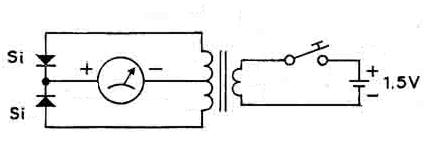
How a transformer works

You probably heard of a transformer. It's a commun and important part in circuits, but what does it do?
This Project will let you find out After you make ail the wiring connections, press the Key whil watching the Meter carefully. Hold down the Key after you press it. What did the Meter do?
Now release the Key. What does the Meter do now?
Can you explain why all this hap-pened? (Here's a clue: look carefully at the schématic symbol for a transformer, It looks like two coils of wire side by side.
Now try to remember what we said about coils of wire carrying electricity back in Project Telegraph ...) Give up?
(Aw c'mon, it's not that hard!) We found out back in Project Telegraph that-a coil of wire carrying electricity sets up a magnetic field.
We also asked you to guess what happens when a magnetic field moves across a coil of wire. The answer is (the envelope please, judges!) that electricity flows in the coil.
What happens here is that a magnetic field moves across the coil of the transformer connected to the Meter when electricity flows through the coil connected to the Batteries. (The electricity flows when you press the Key.) You might wonder why the Meter pointer doesn't stay swung to the right ail the time when you hold the Key down.
This is because the magnetic field must be moving, and it only moves when you press or release the Key. When you hold the Key down, the magnetic field is steady - and no electricity flows is the other coil.
Transformers are very useful in AC circuits because the magnetic field moves whenever the current changes direction. It can also be used in DC circuits if we "interrupt' the DC or vary the voltage so that we cause the magnetic field to move.
Transformers are used to change one voltage to another. They're also used to "match" circuits help différent circuits to "get along" with each Other. We'll see more of how transformers are used in future projects.
